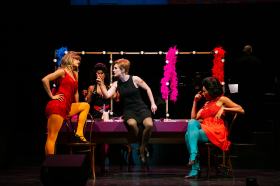Smoke and Mirrors, Image via Flickr
If we go back to the election of the Andrews Labor Government in 2014, Minister Martin Foley changed the portfolio title from “The Arts” to “Creative Industries”, as a gesture towards the way he saw the portfolio developing. This in itself was not a bad concept; recognition that the art sectors (and all the related sectors that broadly fall into it) are indeed an industry, capable of bringing investment and jobs into Victoria.
However, the Arts is also a sector with a unique and important soul, which makes it different to other industries.
Read: Exposing the Creative Industries Fallacy
That aside, the criticism of both the “Creative State” plan and the 2016 Victorian Budget in which it is contained, is that it fails to treat the creative sector as an industry, showing the title up as merely spin.
Industries require longer term planning and vision – along with the supporting funds, where applicable – in order to thrive. “Creative State” does not address long term thinking, and neither does it provide long term funding, or investment strategies.
Much of the funding contained in “Creative State” is to continue ongoing existing programs (many of which pre-date the present Government), which simply keep the arts sector ticking over, such as support for festivals or basic education programs, or the renewal of exhibitions etc. Many of these programs had not been funded in the forward estimates of the 2015 Budget, so the Government is simply making up for a lack of forward funding last year, and calling it “new money”.
Read: 40 ways the arts will improve with $115 m in new funds
The program’s smoke and mirrors go further, raiding $20 million already budgeted for in the Regional Jobs and Infrastructure Fund, and claiming it as new money. Using the fund in this manner isn’t unreasonable per se, however “double counting” the $20 million as “new money” for the arts is deceptive.
Where this funding is used by “Creative State” tends to be for grants that could perhaps be put in the category of “instant gratification”. Yes, it is nice to give money to small and one-off niche programs or ideas, but this is not sustainable, and it doesn’t build the sector. On the contrary, it creates a sector that is more and more dependent on the teat of Government just for the day to day ideas.
Instead, the Government needs to be providing support at a more strategic level, for example:
- investing in training, especially in non-front of house roles in the arts;
- encouraging and improving career pathways into the sector;
- co-funding the development of venues that secure the long term future of organisations;
- supporting regional towns and cities to carve out a unique and sustainable niche within the arts sector; and
- using Government support to attract high profile events and exhibitions etc, which build local awareness of the arts, and brings people back.
We should also be spending more funds on long term attraction of overseas visitors to Melbourne, as a leading arts capital of the Asia Pacific region, and to Victorian cultural offerings more generally. If we can get the foreign dollars flowing, that creates the long term sustainable funding base which in turn allows the sector to grow organically.
The film/TV sector is an even better example of this, and here the 2016 Budget is more or less silent, and lacks any proper funding or strategy for the development of the film, television and game development sector in Victoria.
This is one sector that, if sustained and nurtured properly, can help to replace the car sector as a provider of technical jobs in the State; the potential for jobs growth in the industry is real.
However, this budget:
- fails to include investment in studio facilities to attract tent pole projects to Melbourne;
- fails to articulate programs to train and retain film crew technicians and special effects experts in Victoria;
- fails to invest in growing Victoria’s screen-writing stocks;
- fails to improve tax incentives for attracting screen projects; and
- fails to show how the sector will grow jobs in Victoria under Labor.
Sector consultation over the last 18 months demonstrates clearly that this sector requires the ongoing and regular work that allows writers, production teams, and filming crews to be hired by production houses on an ongoing basis, and not ad hoc, as projects start and end. Government needs to create a pipeline of work into Victoria, addressing the points listed above.
This lack of vision in the Budget will ensure that film sector jobs continue to go to other states, and Victoria will miss out on its slice of a multi-billion dollar world-wide jobs creating industry.
Finally, the proof of this lack of investment is contained in the 2016 Budget’s own figures.
Despite tax revenues going up by 20% over the last two years, Labor has failed to use that money effectively with all key sector indicators falling well below what they were under the former Liberal National Government.
- Attendances at all agencies was 10.2 million in 2014-15, is expected to be 9.7million in 2015-16, and will fall to just 9 million in 2016-17.
- Website visitations for Victoria’s cultural agencies will plummet from 17 million to 14.5 million
- Members and friends of agencies will fall from 48,539 to 45,000.
- Students participating in agency education programs will fall from 575,653 to 500,000.
In the end, the Government can announce a strategy paper with a new, catchy title like “Creative State”, however if their own figures show that the sector is going to go backwards in the next 12 months, that would suggest that the program really is no more than a title.






